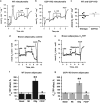Mitochondria-targeted dodecyltriphenylphosphonium (C12TPP) combats high-fat-diet-induced obesity in mice
- PMID: 27534841
- PMCID: PMC5144127
- DOI: 10.1038/ijo.2016.146
Mitochondria-targeted dodecyltriphenylphosphonium (C12TPP) combats high-fat-diet-induced obesity in mice
Abstract
Background: A membrane-penetrating cation, dodecyltriphenylphosphonium (C12TPP), facilitates the recycling of fatty acids in the artificial lipid membrane and mitochondria. C12TPP can dissipate mitochondrial membrane potential and may affect total energy expenditure and body weight in animals and humans.
Methods: We investigated the metabolic effects of C12TPP in isolated brown-fat mitochondria, brown adipocyte cultures and mice in vivo. Experimental approaches included the measurement of oxygen consumption, carbon dioxide production, western blotting, magnetic resonance imaging and bomb calorimetry.
Results: In mice, C12TPP (50 μmol per (day•kg body weight)) in the drinking water significantly reduced body weight (12%, P<0.001) and body fat mass (24%, P<0.001) during the first 7 days of treatment. C12TPP did not affect water palatability and intake or the energy and lipid content in feces. The addition of C12TPP to isolated brown-fat mitochondria resulted in increased oxygen consumption. Three hours of pretreatment with C12TPP also increased oligomycin-insensitive oxygen consumption in brown adipocyte cultures (P<0.01). The effects of C12TPP on mitochondria, cells and mice were independent of uncoupling protein 1 (UCP1). However, C12TPP treatment increased the mitochondrial protein levels in the brown adipose tissue of both wild-type and UCP1-knockout mice. Pair-feeding revealed that one-third of the body weight loss in C12TPP-treated mice was due to reduced food intake. C12TPP treatment elevated the resting metabolic rate (RMR) by up to 18% (P<0.05) compared with pair-fed animals. C12TPP reduced the respiratory exchange ratio, indicating enhanced fatty acid oxidation in mice.
Conclusions: C12TPP combats diet-induced obesity by reducing food intake, increasing the RMR and enhancing fatty acid oxidation.
Figures






References
-
- Skulachev VP. Uncoupling: new approaches to an old problem of bioenergetics. Biochim Biophys Acta 1998; 1363: 100–124. - PubMed
-
- Brand MD. The contribution of the leak of protons across the mitochondrial inner membrane to standard metabolic rate. J Theor Biol 1990; 145: 267–286. - PubMed
-
- Nedergaard J, Golozoubova V, Matthias A, Asadi A, Jacobsson A, Cannon B. UCP1: the only protein able to mediate adaptive non-shivering thermogenesis and metabolic inefficiency. Biochim Biophys Acta 2001; 1504: 82–106. - PubMed
Publication types
MeSH terms
Substances
LinkOut - more resources
Full Text Sources
Other Literature Sources
Medical
Research Materials

